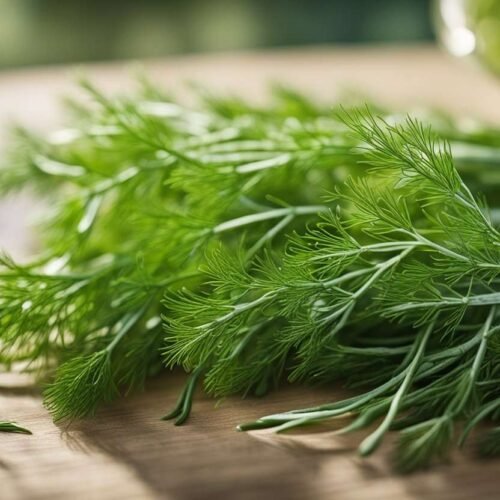If you want to make a Tzatziki recipe but are missing the dill, you have to check these dill substitutes.
Tzatziki is a popular condiment that is commonly served with grilled meats, vegetables, and pita bread. It is a refreshing dip that has a creamy texture and a tangy flavor. It’s a staple of the Mediterranean cuisine.
At its core, tzatziki sauce is made with Greek yogurt, English cucumber, garlic, lemon juice, fresh herbs, and olive oil. The yogurt gives the dip its creamy texture, while the cucumber adds a refreshing crunch. The garlic and lemon juice add a tangy flavor, and the olive oil helps to bind everything together.
Tzatziki is a versatile sauce you can use in many different ways. Common uses include as a dip for vegetables, pita bread, and chips.
You can also use it as a sauce for grilled meats, such as chicken or lamb. Some people even use it as a spread for sandwiches or wraps.
One of the key ingredients in tzatziki is Greek yogurt. Greek yogurt is a thicker and creamier version of regular yogurt. It is made by straining the liquid whey and lactose from the yogurt, which gives it a thicker texture. Greek yogurt is also higher in protein than regular yogurt, making it a healthier option.
Another important ingredient in tzatziki is garlic. Garlic is a staple in Mediterranean cuisine and is known for its pungent flavor and health benefits. It is a natural anti-inflammatory and has been shown to lower cholesterol levels.
The Role of Dill in Tzatziki

Dill is a delicate herb that is commonly used in many dishes, including tzatziki. It has a distinct aroma and a slightly sweet flavor that can elevate the flavors of any dish. In tzatziki, dill plays a crucial role in balancing out the flavors of yogurt, cucumber, and garlic.
The herb has a unique taste that is often described as a combination of anise, citrus, and grassy flavors with a hint of menthol undertones. This makes it an excellent addition to tzatziki, as it adds a refreshing and bright flavor to the dip.
Dill has a distinct aroma, you can describe it as sweet and slightly earthy. This aroma is released when the herb is crushed or chopped, making it a perfect addition to tzatziki, which is a dip that is typically served cold and relies on its aroma to entice the senses.
However, if you are unable to use dill in your tzatziki, there are several substitutes that you can try, including mint and tarragon, which have similar flavor profiles and can add a refreshing twist to the dip.
Substitutes for Dill

1. Mint as a Substitute
Mint is a great substitute for dill in tzatziki. It has a cool and fresh taste that complements the yogurt and cucumber.
You can use fresh mint leaves or dried mint, depending on what you have on hand. Mint is also a common herb used in Greek recipes, so it’s a natural fit for tzatziki.
2. Parsley
Parsley is another herb that you can use as a substitute dill in tzatziki. It has a fresh and slightly bitter taste that pairs well with the other ingredients in tzatziki.
You can use either curly or flat-leaf parsley, depending on your preference. Parsley is also a great source of vitamins and minerals, making it a healthy addition to your tzatziki.
3. Basil
Basil is a herb that has a similar taste to dill, making it a good substitute for tzatziki. It has a slightly sweet and spicy flavor that complements the yogurt and cucumber.
You can use either fresh or dried basil, depending on what you have on hand. Basil is also a popular herb used in Mediterranean cuisine, so it’s a natural fit for tzatziki.
4. Tarragon
Tarragon is a herb that has a similar taste to dill but with a slight anise flavor. It has a fresh and slightly sweet taste that pairs well with the other ingredients in tzatziki. You can use either fresh or dried tarragon, depending on what you have on hand. Tarragon is also a good source of antioxidants, making it a healthy addition to your tzatziki.
5. Cilantro
Cilantro is a herb that has a fresh and slightly citrusy taste that complements the yogurt and cucumber in tzatziki. It has a slightly different taste than dill, but it’s still a good substitute. You can use either fresh or dried cilantro, depending on what you have on hand. Cilantro is also a popular herb used in Mexican and Asian cuisine, so it’s a versatile addition to your tzatziki.
Using Other Herbs as a Substitute
There are several other herbs that you can use as a substitute for dill in tzatziki, such as caraway, thyme, and chervil. These herbs have different tastes than dill, but they can still add flavor to your tzatziki. Experiment with different herbs to find the one that you like the best. Just be sure to use fresh ingredients whenever possible to get the best flavor.
Preparing an Easy Tzatziki with Dill Substitutes

Here’s how you can prepare tzatziki with dill substitutes.
Ingredients
To make tzatziki with dill substitutes, you’ll need the following ingredients:
- 2 cups of plain yogurt or strained yogurt
- 1 medium cucumber, peeled and grated
- 2 cloves of garlic, minced
- 1 tablespoon of lemon juice
- 2 tablespoons of extra virgin olive oil
- 1 teaspoon of kosher salt
- 1/4 teaspoon of ground black pepper
- Dill substitute (see below)
Instructions
- In a large bowl, combine the yogurt, grated cucumber, minced garlic, lemon juice, extra virgin olive oil, salt, and pepper.
- Add your dill substitute of choice to the bowl and mix well. Start with a small amount and add more to taste.
- Cover the bowl and refrigerate for at least 30 minutes to allow the flavors to meld together.
- Serve your homemade tzatziki with pita bread, vegetables, or grilled meats.
That’s it! With these simple steps, you can make delicious tzatziki with dill substitutes that will elevate the flavors of any dish.
Serving Suggestions for Tzatziki

Here are some serving suggestions for tzatziki that you can try at home:
- As a dip: Tzatziki is a perfect dip for vegetables, pita bread, pita chips, and fries. It also goes well with grilled meats, fish, and falafel. Serve it as a side dish or an appetizer at your next party.
- As a dressing: Tzatziki can be used as a dressing for salads, especially Greek salad. It adds a refreshing and tangy flavor to the salad.
- On a sandwich: Tzatziki is a great spread for sandwiches, especially gyros and kebabs. It pairs well with grilled vegetables, bell peppers, tomatoes, and warm pita bread.
- With grilled chicken: Tzatziki is a classic accompaniment to grilled chicken. It adds moisture and flavor to the chicken, making it more delicious.
- With hummus: Tzatziki and hummus make a great combination. Serve them together with pita bread or vegetables for a tasty and healthy snack.
Storage and Shelf Life of Tzatziki
If you have leftovers from your meal or if you made some extra, it is important to store it properly to ensure it stay fresh and safe to eat.
Fridge Storage
Tzatziki should be stored in an airtight container in the refrigerator. Use the coldest part of the fridge, which is usually the back of the bottom shelf. This will help to keep it fresh for a longer period of time.
Shelf Life
Tzatziki can last for up to 5 days in the refrigerator if stored properly. It is important to note that the longer it sits, the more liquid it will release, which can affect the texture and flavor. To prevent this, you can drain any excess liquid before serving.
Vinegar
Some recipes for tzatziki include vinegar, which can help to preserve the sauce. If you choose to add vinegar to your tzatziki, it can extend the shelf life by a few days.
Dairy-Free and Other Variations of Tzatziki
If you’re looking for a dairy-free version of tzatziki, there are plenty of options available. You can use plant-based yogurt or coconut cream instead of dairy yogurt. In fact, many of the search results provide dairy-free variations of tzatziki that you can try.
Can you make tzatziki without using cucumber?

Yes, you can make tzatziki without using cucumber. In fact, there are many recipes available that use alternative ingredients to replace cucumber. Some people may not like the taste or texture of cucumber or may have an allergy to it. Whatever the reason, there are plenty of options to choose from.
Here are some popular substitutes for cucumber in tzatziki:
- Zucchini: This vegetable has a similar texture and taste to cucumber, making it a great replacement. Simply grate the zucchini and add it to the recipe as you would with cucumber.
- Radish: Radish has a slightly spicy flavor that can add a kick to your tzatziki. Grate the radish and add it to the yogurt mixture for a unique twist on the classic recipe.
- Carrot: Grated carrot can add a sweet and crunchy element to your tzatziki. It’s also a great way to sneak in some extra veggies.
- Bell pepper: Chopped bell pepper can add a colorful and flavorful addition to your tzatziki. It’s a great way to add some crunch and sweetness to the recipe.
If you are making tzatziki without cucumbers, it’s important to keep in mind the other flavors in the recipe. Make sure to keep the right ratio so you don’t overpower the sauce.
In conclusion, making tzatziki without cucumber is easy and can be just as delicious as the original recipe. With a variety of vegetable substitutes and herb options available, you can customize your tzatziki to your liking.

Tzatziki Without dill
Ingredients
- 2 cups of plain yogurt or strained yogurt
- 1 medium cucumber, peeled and grated
- 2 cloves of garlic, minced
- 1 tablespoon of lemon juice
- 2 tablespoons of extra virgin olive oil
- 1 teaspoon of kosher salt
- 1/4 teaspoon of ground black pepper
- Dill substitute
Instructions
- In a large bowl, combine the yogurt, grated cucumber, minced garlic, lemon juice, extra virgin olive oil, salt, and pepper
- .Add your dill substitute of choice to the bowl and mix well. Start with a small amount and add more to taste.
- Cover the bowl and refrigerate for at least 30 minutes to allow the flavors to meld together.
- Serve your homemade tzatziki with pita bread, vegetables, or grilled meats.
Notes
| Nutrition Facts | |
|---|---|
| Servings: 4 | |
| Amount per serving | |
| Calories | 145 |
| % Daily Value* | |
| Total Fat 7.1g | 9% |
| Saturated Fat 1.1g | 5% |
| Cholesterol 5mg | 2% |
| Sodium 634mg | 28% |
| Total Carbohydrate 8.4g | 3% |
| Dietary Fiber 0.5g | 2% |
| Total Sugars 4.4g | |
| Protein 12.1g | |
| Vitamin D 0mcg | 0% |
| Calcium 166mg | 13% |
| Iron 0mg | 3% |
| Potassium 123mg | 3% |
| *The % Daily Value (DV) tells you how much a nutrient in a food serving contributes to a daily diet. 2,000 calories a day is used for general nutrition advice. | |
| Recipe analyzed by |
|



